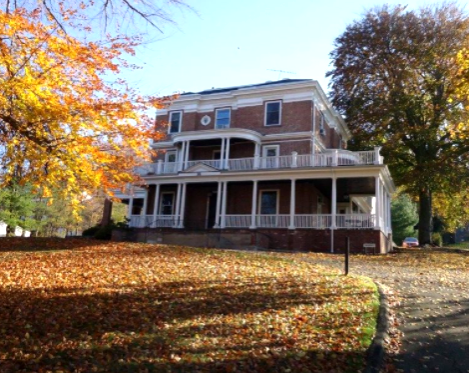Repose: Home to mayors, school, convalescent facility, business
 |
The “Repose” estate was established in about 1850 and its owner, Edmund Coffin, played a key role in the development of Irvington after the arrival of the railroad. This building, known as Chatenay by George E. Dickinson after his purchase of the estate, was built in 1910 and looks remarkably similar today. (Google Maps Street View)
Real estate developer Edmund Coffin purchased a small property he would call “Repose” at what is now 106 North Broadway in Irvington, N.Y., in about 1850. It was the same time Dearman Town -- later Irvington -- arose out of an auction of lots along what are now Main Street and its rib of north-south side streets from what was the Justus Dearman farm.
The auction came about a year after the railroad first reached what would become Irvington and Coffin, financier George D. Morgan and banker, shipping magnate and U.S. Congressman Moses Hicks Grinnell would play key roles in the village’s development.
Repose lay just a hundred yards or so north of Morgan’s estate, also on North Broadway. Repose was reached by a circular driveway east off Broadway on which the main house stood and the driveway extended past the house towards the back of the property where stables and a carriage house once stood.
Grinnell’s summer estate was off Sunnyside Lane next to Sunnyside, the estate of author Washington Irving, a known close friend of both Grinnell and Morgan, who led the charge to change Dearman Town’s name to Irvington in 1854 in honor of Irving.
Coffin is the great-grandfather of the Rev. William Sloane Coffin Jr., a clergyman and long-time peace activist and Civil Rights Movement leaders who once served as Yale University chaplain and led Riverside Church in Manhattan. Coffin (1924-2006) was one of the nation’s first gay rights advocates.
Coffin, a complex character, was also a World War II U.S. Army veteran and a Central Intelligence Agency agent after the Korean War (1950-53).
The Coffin estate was purchased by coal entrepreneur George E. Dickinson in 1900. Dickinson renamed it “Chatenay” after a Paris suburb. He went on to serve several terms as president of the village's board of trustees -- mayor in current parlance -- around the year 1920. His son, Herbert C. DIckinson, later became mayor in his own right.
G.E. Dickinson frequently visited his sister in France after leaving office and he died there in 1938. The estate was purchased in 1939 by Margaret Bradbury, who operated a private convalescent home at the site until her death in 1953.
In 1959 Repose would become home to Hudson River Country Day School, a private school for between 50 and 100 students pre-K through grade 8. The school had previously been on The Masters School campus in Dobbs Ferry and before that at a Hastings site beginning with its foundation in 1924.
It remained a school through the 1960s and ‘70s, but eventually was returned to private ownership and hosts business offices today. It has recently been home to offices of advertising and security companies.
 |
Edmund Coffin’s “Repose” lay on the east side of North Broadway and south of East Sunnyside Lane. (Frederick W. Beers, 1891, David Rumsey Map Collection, DavidRumsey.com) |










Comments
Post a Comment
If you would like to weigh-in, feel free ...